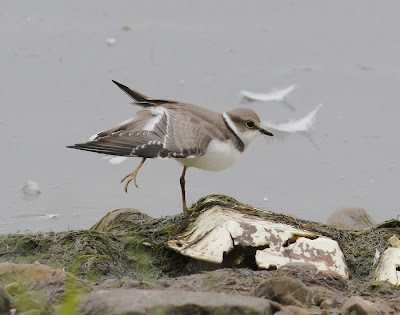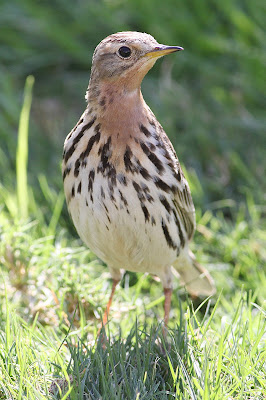A rainy old morning, so with no bird news today's post concerns a new book which should interest many bird watchers.
My friends at Princeton University Press sent a book for review on Another Bird Blog - Tracks and Signs of the Animals and Birds of Britain and Europe. So while it’s a book that isn’t just about birds it is one that many birders will be interested in hearing of.
The book’s publication data shows that it was first released in Denmark in 2012 as Dyr & Spor (Animals and Tracks). The author Lars-Henrik Olsen is a zoologist, writer and lecturer who has worked at the Copenhagen Zoological Museum and the World Wildlife Fund, and is the producer of a number of Danish radio and television programmes. The book is available at
Princeton University Press for £17.95.
Tracks and Signs of the Animals and Birds of Britain and Europe
As a bird watcher and field worker and on my regular explorations, I often come across little bits of the unknown, whether they be tracks in mud or grass, paths through a field, scats, pellets, skulls or the many signs of feeding by birds or mammals. With the simple things it isn’t too bad whereby I can assign an owl pellet to a species, recognise signs of woodpecker activity, distinguish fox poo from domestic dog dirt and know when a deer has walked a muddy path. More often than not I cannot answer the more difficult conundrums that nature and animals leave in their wake. Any book that can help explain such mysteries is welcome indeed, so I set about this book with a great deal of interest and enthusiasm, hoping to learn a little more about the countryside and the animals in it.
Tracks and Signs of the Animals and Birds of Britain and Europe
“Tracks and Signs” has an unusual and tiny introduction of less than half a page, sufficient enough since the book’s title, likely contents and probable usage are in themselves self-explanatory. It was actually a welcome change not to read pages and pages of introduction, preface and "how to use this book", but instead to get down to the nitty-gritty as soon as Page 6.
Roughly the first third of the book is devoted in several pages of each section to describing, illustrating and annotating the clues that birds and animals leave behind. The headings to these sections include for instance, antlers, bird and animal tracks, feeding signs on trees and on crops, pellets, nests & dens, and summaries of bird droppings, the scats of carnivores, small mammals, rodents and small herbivores. I found some really useful snippets of information in these sections e.g. why Brown Hares and Rabbits shear off the branches of trees in contrast to deer which twist branches until they break, and how different the results appear to a trained human eye: or how to tell which bird or animal has been eating the fruit of rose hips. There are lots more secrets of wildlife in these pages, interspersed as they are with the splendid photographs, illustrations and drawings. The publishers don’t quote the number of photographs but at 4 or 5 per double page spread it must reach into many hundreds.

Tracks and Signs of the Animals and Birds of Britain and Europe
The remaining 170 pages of the book are devoted to the specific mammal species, with information on size, distribution, behaviour and habitat as well as a more detailed summary of tracks and scats. There are many fine photographs in this book, not just of the marks, signs and tracks themselves, but photographs which do not show an animal or bird in simple isolation but which relate in a very informative and useful way to the textual account. For instance, and even as hard as it is to select one or two from so many, the Red Fox leaving tracks in the snow or sand as it listens for mice; the Wolf at a den accompanied by pictures of a Wolf’s hind foot together with a picture of Wolf tracks in the sand; or the Mink clamped on a Mallard complemented by pictures of a Mink scat and typical remains at a Mink’s den.
Tracks and Signs of the Animals and Birds of Britain and Europe
If anything Tracks and Signs is rather “light” on birds, focusing mainly on tracks in relation to footprints of larger waders, ducks/geese and game birds, feeding signs on fruit, nuts and cones, pellet ID or the signage that raptors make. Some of the birds shown do not occur in the UK or occur very rarely e.g. Nutcracker, Hawk Owl, Three-toed Woodpecker, species which are much more relevant to the original book written in Danish and targeted at a non-UK audience.
On the other hand the book is voluminous on mammals, perhaps a welcome change for most bird watchers who like me proably have far too many books which are all about birds to the exclusion of other wildlife. In fact we bird watchers are sometimes so focused on, some might say obsessed by, birds that we miss out or fail to engage with other wildlife, despite the (hopefully) innate curiosity which initially fuelled the interest in wild birds. This book isn’t aimed at simply bird watchers, more at amateur field workers and naturalists of many persuasions and specialised interest who are out to broaden their knowledge and expertise of birds or mammals.
The 175 creatures covered in the 270 pages range in size from the tiny House Mouse up to the rather larger Brown Bear and include along the way rarely seen species such as Pine Marten, Wolverine, Common Dormouse or the Wildcat.
Tracks and Signs of the Animals and Birds of Britain and Europe
When I started to dip into the book I realised what a wealth of animals the rest of Europe has in comparison to the islands of Britain and Ireland, surrounded as we are by a number of seas. There are animals featured in the book which I had not heard of, for instance Raccoon Dog Nyctereutes procynoides, not be confused with the North American Raccoon Procyon lotor which also breeds in Belgium and Denmark but from introduced stock. Then there is the European Souslik Sperophilius citellus, a large rodent found near The Black Sea, a few species of voles found only in Scandinavia, or the Mouflon Ovis orientalis, a large goat from Corisca and Sardinia with a wild population in mainland Europe established by escapees from nature parks and zoos. The point is that the book covers an awful lot of species which a UK reader will never encounter unless they travel extensively in Europe.
It was while studying some of these detailed pictures in the 6x9 inches of the book, a size clearly intended as a field companion that I thought it would benefit from a larger format. As such it would make a superb coffee table volume and home-based reference where the many photographs and illustrations would display at their very best and allow greater study of their detailed elements.
That is not to say that anyone in the UK will not enjoy reading, dipping into or actually using this book in the field, albeit it in a somewhat limited way in mammal-deficient Britain. On the contrary; it is a book to enjoy and to savour, one which is packed full of insight to offer the reader a whole new way of thinking about the birds and animals which have left marks for us to fathom. If anyone has a particular interest in learning how to track animals they should buy this book. If on the other hand they are someone who likes to understand the countryside and delve below the surface more than a little, this book will help them to do just that in a handy-sized, non-scientific, and highly readable guide.
Tracks and Signs of the Animals and Birds of Britain and Europe
Now you must excuse me, I'm off to look around the garden. More soon from Another Bird Blog
















































































